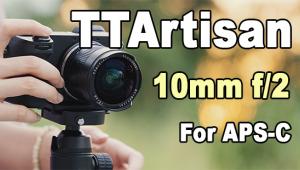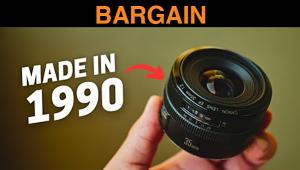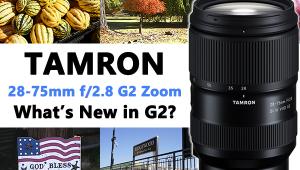Carl Zeiss Planar T* 85mm f/1.4 And Planar T* 50mm f/1.4; Lenses For Low-Light Photography And More…
There is no doubt that Carl Zeiss is one of the magical names in the world of optics and so the introduction of the Zeiss ZE lenses for analog and digital cameras is big news. The lenses I tested were provided in Canon EF mount and I used them with two different Canon EOS D-SLRs. As with all EF compatible lenses, the new Carl Zeiss ZE lenses transfer data to the camera through the use of electronic contacts in the lens mount. This means that all of your camera’s Exposure modes are supported; the aperture setting is controlled from the camera body, and focus confirmation—these are, after all, manual focus lenses—is available. Even E-TTL flash metering is supported. Of course, all of that lens and exposure information can be accessed via the EXIF data, should you use these lenses with D-SLRs. The first lenses available to us for test were the Planar T* 85mm f/1.4 ZE and the Planar T* 50mm f/1.4 ZE, with additional focal lengths promised soon.
 |
Planar T* 85mm f/1.4
The Planar lens design was created by Paul Rudolph at Carl Zeiss in 1896 and originally featured a six-element symmetrical design. Today’s Planar T* 85mm f/1.4 lens is optimized for medium to longer distances and provides distortion-free performance that only improves when the lens is stopped down. The relatively fast f/1.4 aperture is useful for creatively controlling depth of field and the nearly circular diaphragm creates pleasing bokeh in out-of-focus areas. Bokeh is an optical buzzword that describes the pleasing quality of an image’s out-of-focus areas. It’s a little more subjective than the Richter scale but most photographers know good bokeh when they see it, even if they don’t know the term.
 |
The Planar T* 85mm f/1.4 lens is available in F (ZF, read Nikon), EF (ZE, read Canon autofocus), and K bayonet (ZK, read Pentax and others) lens mounts and is designed for use with full-frame digital or film SLRs. When used with a D-SLR with a 1.6x multiplication factor, such as a Canon EOS 50D, the lens shows the field of view captured by a 135mm focal length lens. This short telephoto is a classic portrait focal length that, according to Carl Zeiss, is “enhanced by long barrel rotation for precise control of focusing.” The precise focusing mechanism gives you time to concentrate on the subject and the quality design and construction produces brilliant, distortion-free images over the entire image. On the output side those same images exhibit the kind of sharpness that the name Zeiss exemplifies.
 |
|
|
The Planar T* 85mm f/1.4 lens fits comfortably in a niche left in Canon’s EF lens line-up between the versatile EF 85mm f/1.8 USM and the hefty in price ($2149) and weight (36 oz) EF 85mm f/1.2L II USM. With its near-focusing capability of 39.3”, the Planar T* 85mm f/1.4 lens could not be considered a close-focusing lens and I found myself using the old technique of racking the lens all the way in and then moving my body to bring the subject into focus. This process is aided and abetted by the crisp image displayed in the viewfinder courtesy of the f/1.4 aperture.
 |
|
|
That “long barrel rotation” is clearly designed for the deliberate photographer, not the shoot-and-scoot-style shooter who thrives on fast autofocus. Under most conditions the best focusing technique for me turned out to be to compose the subject and bring the area I wanted into focus while waiting for focus confirmation to appear in the viewfinder. This was especially true when I used the Planar T* 85mm f/1.4 in the studio, where the reassuring chirps of the EOS-1D Mark II N let me know that the portrait I was making was in focus.
Planar T* 50mm f/1.4
The Planar T* 50mm f/1.4 provides high-performance capture even when wide-open, all of which only improves as the lens is stopped down. The lens construction controls flare and ghosting artifacts, resulting in a brilliant image with excellent contrast and natural color rendition. The Planar T* 50mm f/1.4 lens is a high-speed “standard” lens that testing lab specialists have rated as the best standard SLR lens in the world. And ya gotta believe this just from the feel of the lens when mounting it on your camera.
The Planar T* 50mm f/1.4 isn’t just a lens; it’s an optical instrument whose precise mechanical construction allows highly accurate manual focusing. Its outstanding color rendition and brilliance, when combined with good internal color balance in your D-SLR, minimizes off-color problems in all but the most challenging lighting situations. This bright and compact lens has a precise manual focusing mechanism and that same “large rotation angle for precise control” feature of the 85mm, but here it feels more natural and there’s much less focusing action required. This will be a big plus for those readers who grew up using autofocus cameras and may never have focused a lens. Don’t be afraid. It’s not only easy but gets you closer to the subject by making the process more interactive.
 |
|
|
The bright viewfinder image the Planar T* 50mm f/1.4 produces wide-open, especially when working under less than ideal lighting conditions, which makes focusing a snap when doing night photography. Making portraits outdoors with a full-frame D-SLR, such as the EOS 5D, using only the illumination from holiday lights was surprisingly easy. The big challenge for me was making sure to hold the camera steady enough to pull the maximum sharpness that this optically amazing lens can produce. My cold weather testing of the Planar T* 50mm f/1.4 was made when the temperature was in the mid-teens (F) in Colorado and the lens performed just as smoothly as if it was a sunny day on the beach in Florida.
 |
|
|
- Log in or register to post comments

















































